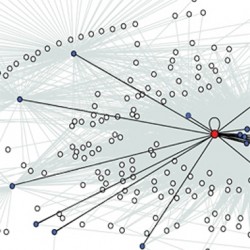 CSC study identifies kingpin gene in type 1 diabetes
CSC study identifies kingpin gene in type 1 diabetes
CSC Group Heads Stuart Cook and Enrico Petretto have identified an important network of genes that contributes to the risk of developing Type 1 Diabetes (T1D). The work has been published in Nature.
Previous research correlating human disease to particular genetic variants has tended to concentrate mainly on genetic association, paying less attention to genes expression and how it influences physiology. In this study, integration of computational gene expression analyses, rat and human genetics, and functional approaches has allowed the team to go beyond standard genome-wide association studies and identify not only the genes in the network, but also the key players – the key genes that play major roles in determining disease.
Stuart Cook gave this analogy:
“If we think about our genes as being similar to a football team – it is one thing to know that the team you’re playing against has 11 players, but another to know who their main match winners are. What we find exciting about these results is that, for the first time, we have been able to identify the most important genes – who the strikers are, as well as who the team captain might be that coordinates the other players. Applying this knowledge to find out more about the key players that cause disease will help researchers find better ways to develop more targeted treatments in the fight against diabetes.”
The study identifies one particular gene, Ebi2, lying at the locus of a transcription factor-driven inflammatory gene network for IRF7 – a transcription factor associated with T1D. The results also emphasise the important role of transcription factors like IRF7 in mediating genetic expression and ultimately influencing physiology.
This development will help researchers focus their efforts to improve drug treatments for type 1 diabetes and could have an impact on other diseases where inflammation plays an important role.
Reference:
Heinig, M., Petretto, E., Wallace, C., Bottolo, L., Rotival, M., Lu, H., Li, Y., Sarwar, R., Langley, S. R., Bauerfeind, A., Hummel, O., Lee, Y.-A., Paskas, S., Rintisch, C., Saar, K., Cooper, J., Buchan, R., Gray, E. E., Cyster, J. G., Erdmann, J., Hengstenberg, C., Maouche, S., Ouwehand, W. H., Rice, C. M., Samani, N. J., Schunkert, H., Goodall, A. H., Schulz, H., Roider, H. G., Vingron, M., Blankenberg, S., Munzel, T., Zeller, T., Szymczak, S., Ziegler, A., Tiret, L., Smyth, D. J., Pravenec, M., Aitman, T. J., Cambien, F., Clayton, D., Todd, J. A., Hubner, N., Cook, S. A., September 2010. A trans-acting locus regulates an anti-viral expression network and type 1 diabetes risk. Nature advance online publication. http://dx.doi.org/10.1038/nature09386
Novel statistical approaches have previously been shown to be useful in detecting groups of genes that act together to disease. Publications from CSC groups have demonstrated the power of a method called Sparse Bayesian Regression in elucidating the more subtle of these interactions. When applied to analyses of multiple tissue types, connections between disease genes missed by other analytical methods have been illuminated. The method was used to determine the key role Ebi2 has in the IRF7 gene network.
